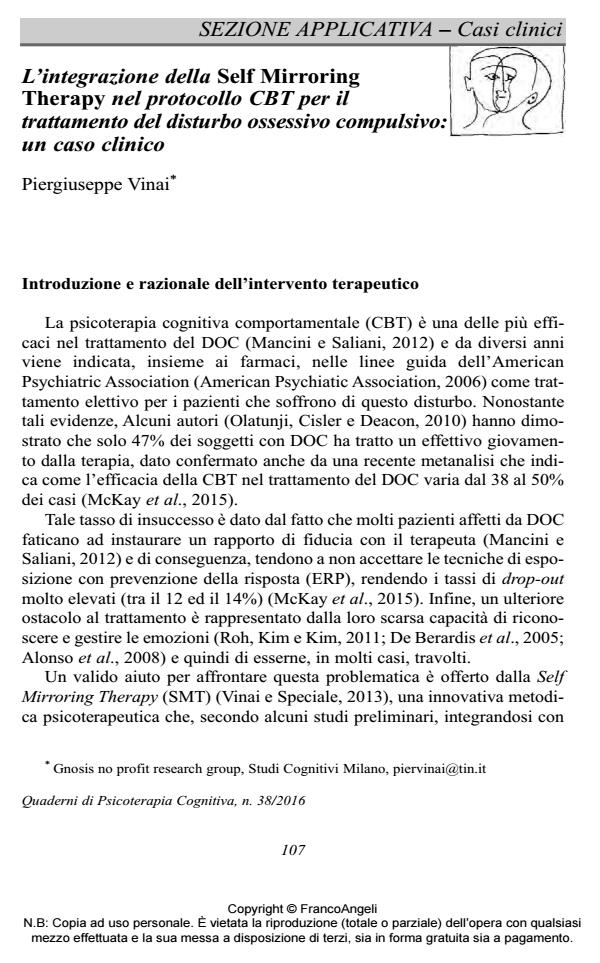Implementation of the CBT efficiency in treating DOC patients with the Self Mirroring Therapy: a case report
Journal title QUADERNI DI PSICOTERAPIA COGNITIVA
Author/s Piergiuseppe Vinai, Maurizio Speciale, Michela Alibrandi
Publishing Year 2016 Issue 2016/38
Language Italian Pages 10 P. 107-116 File size 91 KB
DOI 10.3280/QPC2016-038008
DOI is like a bar code for intellectual property: to have more infomation
click here
Below, you can see the article first page
If you want to buy this article in PDF format, you can do it, following the instructions to buy download credits

FrancoAngeli is member of Publishers International Linking Association, Inc (PILA), a not-for-profit association which run the CrossRef service enabling links to and from online scholarly content.
Cognitive behavior therapy have been proved to be the most efficient psycotherapeutic treatment for the obsessive compulsive disorder (OCD) with remission rate variating from the 38 to the 50% of the cases. One of the main difficulties encountered while treating OCD patients, it is the difficulty of this subject to recognize and deal whit their emotions. Avalid support to the treatment, it’s the integration of the usual validated protocol with the Self Mirroring Therapy (SMT). This paper reports the clinical case of Marta, a 35 years old woman with obsessive compulsive disorder and treated with the "Cognitive Model of the Obsessive Compulsive Disorder" (Mancini, 2004), combined with the SMT. The therapy has been structured in five different stages, during which the different aspects of the disorder has been treated trough video registration of ABC. After six month from the end of the treatment, signs of the disorder were impossible to find in the patient behavior, who eventually allowed herself to listen her emotions and to accept herself the way she is, whit all her faults and defect.
Keywords: Self Mirroring Therapy, Obsessive Compulsive Disorder, Mirror Neurons, Alexithymia Cognitive Behavioral Therapy
- Explicit and Implicit Responses of Seeing Own vs. Others’ Emotions: An Electromyographic Study on the Neurophysiological and Cognitive Basis of the Self-Mirroring Technique Alessandra Vergallito, Giulia Mattavelli, Emanuele Lo Gerfo, Stefano Anzani, Viola Rovagnati, Maurizio Speciale, Piergiuseppe Vinai, Paolo Vinai, Luisa Vinai, Leonor J. Romero Lauro, in Frontiers in Psychology 433/2020
DOI: 10.3389/fpsyg.2020.00433
Piergiuseppe Vinai, Maurizio Speciale, Michela Alibrandi, L’integrazione della Self Mirroring Therapy nel protocollo CBT per il trattamento del disturbo ossessivo compulsivo: un caso clinico in "QUADERNI DI PSICOTERAPIA COGNITIVA" 38/2016, pp 107-116, DOI: 10.3280/QPC2016-038008